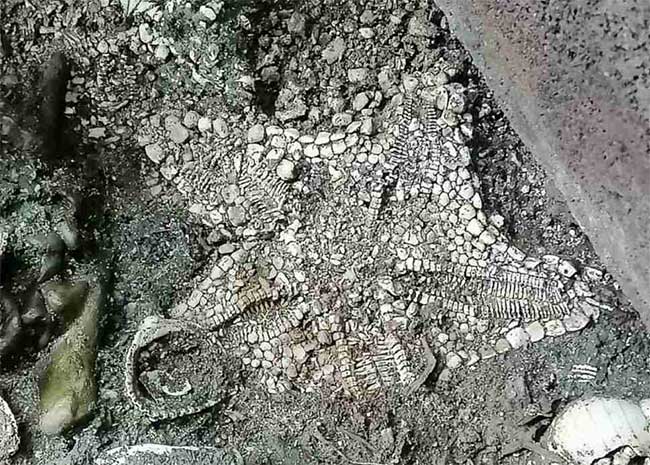With its location deep inland, this discovery adds to the mysterious veil still surrounding this sacred temple.
Scientists working on the Templo Mayor Project (PTM) have found this special specimen in a tezontle stone offering box (a material commonly used by ancient Central American cultures) measuring 1.4 meters long and nearly 1 meter wide, labeled 178. According to archaeologist Miguel Báez, at the center of the box lies the fossil of a large feline, likely a female jaguar, along with a severely damaged bronze statue approximately 20 cm long, which seems to represent a water deity.

Starfish fossil.
One factor that makes box 178 stand out to scientists is the remnants of gorgonian corals and the fossils of numerous starfish, but none of the specimens have a structure and shape nearly as perfect as the newly discovered one. Báez noted that this special specimen was found in the fourth excavation layer, estimating that there are over 100 starfish specimens in this box. It appears that all these specimens belong to the same species, suggesting that at some point, the ancient people transported an entire group of starfish, corals, and the jaguar to this location.
After decades of excavation, scientists have discovered specimens of tens of thousands of species at Templo Mayor, categorized into six main groups: sponges, echinoderms, cnidarians, arthropods, mollusks, and chordates (such as cartilaginous fish, bony fish, amphibians, reptiles, birds, and mammals). Specimens of frogs, rabbits, turtles, deer, and especially fossils of domesticated animals like turkeys and dogs are also quite common. However, the presence of the starfish Nidorelia armata is particularly unique, as this species has the characteristic of dying just minutes or hours after leaving the marine environment. Therefore, the question arises as to how the ancient Mexica could transport such a massive number of starfish over 300 km inland from the Pacific Ocean.
To explain the presence of marine creatures alongside the jaguar, archaeologist Miguel Báez suggests that it relates to the worldview of the ancients. They believed that creation consisted of three great realms: one was the underworld represented by water; the earth where humans lived, represented by terrestrial animals like snakes and mammals; and the sky of birds. In box 178, the marine creatures represent the ocean or the underworld, but scientists are still uncertain about what the jaguar symbolizes. Typically, animals would be adorned for sacrifice, but archaeologists have yet to obtain a complete image of the jaguar, the artifacts, and the symbolic forms buried with the animal.
Templo Mayor (meaning Great Temple) is a monument of the Mexica who ruled the Aztec Empire in the 14th and 15th centuries. Templo Mayor is the sacred heart of Tenochtitlan – the Aztec capital, and it is believed to be the site of many sacrifices. Archaeologists first discovered the remains of the Templo Mayor in 1914. However, excavation at this archaeological site did not truly commence until the 1970s. This historical center of Mexico City was recognized as a World Heritage Site by the United Nations Educational, Scientific and Cultural Organization (UNESCO) in 1987.


















































